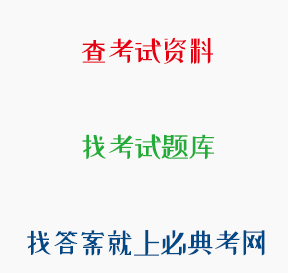正确答案: C
Distrust.
题目:根据以下材料回答{TSE}题:Age DiscriminationBy the year 2000 nearly half the workforce in Europe are over 40 and yet throughout Europe there is a deep ambivalence ( 犹豫 )-if not outright suspicion-towards the capabilities of older workers.Those over the age of 40 generally take longer to find new employment, but European governments have done little to protect their employment rights. Only Germany, with incentives to business to encourage the employment of older people, and France, with the introduction of legislation making it illegal to use age barriers in recruitment-or to make employees redundant because of their age done anything substantive to combat age discrimination.Yet even in these two countries, there has been no noticeable improvement in the lot of the older workers; indeed, in France, job advertisements flout ( 轻视,反对 ) the law openly by asking for applicants of a certain age. So, should France and Germany be tightening up their laws and should the rest of Europe follow suit?Bill Robbins, a careers consultant said, "Legislation against age discrimination has been in existence for well over ten year in the U.S. and Canada, but has had no effect. Employers will always be able to find some reasons for turning down an older applicant without appearing to break the law."Ironically, it was governments which played a leading role in hardening business culture against older workers in the first place. In the late 1970s, many European countries were extremely concerned about the levels of youth unemployment, and France, Germany and Belgium even initiated incentive schemes for businesses to encourage older employees to take early retirement provided that younger trainees were taken on in their place. As more and more employees took early retirement, often willingly, a new, youth-oriented culture permeated business throughout most of Europe-even in those countries that had taken no active measures to promote it.Demographic ( 人口统计学的 ) trends mean that governments are now anxious to slow down the policy of early retirement as they realize that they simply do not have the funds to meet their pension promises. But reversing business attitudes is no easy matter. Dianah Worman a policy adviser said, "There is a widely held belief that older people are less, adaptable and trainable. This is just not true: research has shown that differences in capability are as wide within age groups as they are between them."{TS}Which of the following words can best describe the European attitude to older workers?
解析:【解析】从文章第一段可以看出欧洲人对年龄较大的工作者存在着不信任的态度,suspicion(怀疑)即是distrust(不信任)。
学习资料的答案和解析:
clause
回答下面的题目:Traffic in Uur CitiesTile volume of traffic in many cities in the world today continuesto expand.This causes many problems,including serious air pollution,lengthydelays,and the greater risk__________ (51)accidents.Clearly,something must be done,but it is often difficult to persuade people to__________ (52)theirhabits and leave their cars at home.One possible__________ (53)is to make it more expensive for peopleto use their cars by__________ (54)charges for parking and__________ (55)tougherfines for anyone who__________ (56)the law.In addition,drivers could be required to pay for using particular routes atdifferent times of the day.This system,__________ (57)as“road pricin9”,is alreadybeing introduced in a__________ (58)of cities,using aspecial electronic card__________ (59)to the windscreen of the car.Another way of__________ (60)with the problem is to provide cheapparking on the__________ (61)of the city,and strictly control the number ofvehicles allowed into the centre.Drivers and their passengersthen use a special bus__________ (62)for the final stage of their journey,Ofcourse.the most important__________ (63)is to providegood public transport.However,toget people to__________ (64)the comfort of their cars,publictransport must be felt to be reliable,convenient andcomfortable,with fares__________ (65)at an acceptablelevel.
回答下面的题目:Screen TestEvery year millions of women are screened with X-rays to pick up signs of breast cancer.If this happens early ecough, the disease can often be treated successfully.According to a survey published last year, 21 countries have screening programmes.Nine of them, including Australia, Canada, the US and Spain, screen women under 50.But the medical benefit of screening these younger women are controversial, partly because the radiation brings a small risk of inducing cancer.Also, younger women must be given higher doses of X-rays because their breast tissue is denser.Researchers at the Polytechnic University of Valencia analysed the effect of screening more than 160,000 women at 11 local clinics.After estimating the women’s cumulative dose of radiation, they used two models to calculate the number of extra cancers this would cause.The mathematical model recommended by Britain’s National Radiological Protection Board (NRPB) predicted that the screening programme would cause 36 cancers per 100,000 women, 18 of them fatal.The model preferred by the UN Scientific Committee on the Effects of Atomic Radiation led, to a lower figure of 20 cancers.The researchers argue that the level of radiation-induced cancers is “not very significant” compared to the far larger number of cancers that are discovered and treated.The Valencia programme, they say, detects between 300 and 450 cases of breast cancer in every 100,000 women screened.But they point out that the risk of women contracting cancer from radiation could be reduced by between 40 and 80 percent if screening began at 50 instead of 45, because they would be exposed to less radiation.The results of their study, they suggest, could help “optimise the technique” for breast cancer screening.“There is a trade-off between the diagnostic benefits of breast screening and its risks.” admits Michael Clark of the NRPB.But he warns that the study should be interpreted with caution.“On the basis of the current data, for every 10 cancers successfully detected and prevented there is a risk of causing one later in life.That’s why radiation exposure should be minimised in any screening programme.”Paragraph 2_____
Small Risk of Inducing Cancers from Radiation
根据以下资料,回答下面的题目。 请在第____处填上正确答案。
conduct
Right
- Goethe often did outdoor skating and swimming.
- Since the birth of the Barbie doll it has served as a sign t
- 外语考试2022职称英语历年考试试题试卷(6S)
- According to the passage, it may soon be possible__________
- The last few weeks have been enjoyable
- 请在第__(60)__处填上正确答案。
- 第65题应选:
- She can speak French and German, let alone English.
- The representation of a cultural phenomenon is usually a lo
- 职称英语2022冲刺密卷正确答案(04.07)

 川公网安备 51012202001360号
川公网安备 51012202001360号